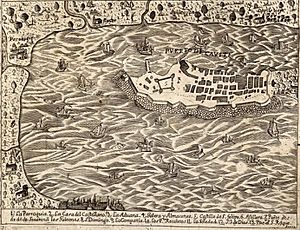Fort San Felipe (Cavite) facts for kids
Quick facts for kids Fort San Felipe |
|
|---|---|
| La Fortaleza de San Felipe | |
| Part of Naval Base Cavite | |
| Cavite City in the Philippines | |
|
Location of Fort San Felipe in the Philippines
|
|
| Coordinates | 14°28′54.5″N 120°55′0″E / 14.481806°N 120.91667°E |
| Type | Fortress |
| Site information | |
| Owner | Government of the Philippines |
| Controlled by | Philippine Navy |
| Open to the public |
No |
| Condition | Partly demolished in the early 20th century |
| Site history | |
| Built | 1609 |
| Built by | Spanish East Indies |
| Materials | Granite and concrete |
| Battles/wars | Battle of Manila Bay |
| Events | Cavite mutiny of 1872 Execution of the Thirteen Martyrs of Cavite in 1896 |
Fort San Felipe (which means Fortress of San Felipe in Spanish) is an old military fortress in Cavite City, Philippines. The Spanish military built it in 1609. It was made to protect the first port town of Cavite, which is now part of Cavite City.
Today, less than half of the original fort remains. The parts that are left are made of strong granite blocks. Its walls are about 30 feet high. There's a wide stairway that leads to the top of the fort's towers, called bastions. You can see old cannons and cannonballs on the fort's lawns.
Fort San Felipe is located inside the Naval Base Cavite. This base belongs to the Philippine Navy. Because it's a military area, the fort is not open to the public. The name Fort San Felipe can also mean the area of Cavite City where the old port and naval base were located.
Contents
History of Fort San Felipe
In 1591, Governor Gomez Perez Dasmariñas saw how important Cavite Puerto was. It was like a main entrance to the City of Manila. So, he decided it needed strong defenses. Years before, Miguel de Legazpi had even hidden his ships there before attacking Manila.
Building the Fort
Fort San Felipe was built between 1609 and 1616. It was the first military fortress in the province of Cavite. It was built when Juan de Silva was the Governor-General of the Philippines.
A report from 1659 by Governor Sabiniano Manrique de Lara described the fort. It was shaped like a square with four corner towers. It was about 220 feet around. The fort was built to face the Cavite Port and Manila. There was also a platform nearby for 10 cannons. It was named after Saint Catherine of Alexandria.
In August 1663, Governor Sabiniano Manrique de Lara ordered another platform to be built. This one was at the entrance of Fort San Felipe and could hold 10 cannons. Over the next few years, four more platforms were added. Each of these was named after a Catholic saint.
From 1679 to 1688, the fort was used as a prison. One famous prisoner was Fernando de Valenzuela, 1st Marquis of Villasierra. He was a close advisor to the Queen Regent Mariana of Austria.
The Cavite Mutiny of 1872
The Cavite Mutiny was an uprising that happened on January 20, 1872. Military workers and soldiers at the Spanish arsenal in Cavite, including Fort San Felipe, rebelled. About 200 soldiers and workers, led by Sergeant Francisco La Madrid, rose up. They hoped it would start a bigger national uprising.
The governor of the fort was killed during the event. However, the uprising was quickly stopped by January 22. The Spanish government soldiers executed many of the people who took part. They also started to crack down on a growing movement for Filipino independence.
This uprising sadly led to the unfair execution of three Filipino priests. They were Mariano Gomez, Jose Burgos, and Jacinto Zamora. They were executed by garrote on February 17, 1872. Many people believe that the Cavite Mutiny of 1872 was the start of Filipino nationalism. This feeling eventually led to the Philippine Revolution in 1896.
The Cavite Conspiracy and the Thirteen Martyrs
On September 12, 1896, thirteen Filipino heroes were executed. They were taken to the Plaza de Armas, just outside Fort San Felipe. They were killed by musketry (shot by soldiers). These thirteen people were leaders of a planned uprising at the Cavite Arsenal. The plan was discovered on September 3.
After the Spanish authorities learned about the plan, they quickly arrested Severino Lapidario, Alfonso de Ocampo, and Luis Aguado. The rest of the group were rounded up on September 3. Their names were revealed by De Ocampo after he was tortured. This group of heroes is now known as the Thirteen Martyrs of Cavite.
Among those captured was Julián Felipe, a musician. He later composed the Philippine national anthem. Felipe was held at Fort San Felipe for nine months. Some others, like Pablo and Marcos José, and Juan Castañeda, were later released.
American Control
When the Americans took control of the Philippines, they made changes to the fort. In the early 1900s, they demolished most of the old port. Only the front part, the main entrance with its side walls, and the two end towers were left. The Americans tore down parts of the fort to build a naval station.
Today, Fort San Felipe is still located inside Naval Base Cavite. Because it is part of an active military base, it is not open to the public.
See also
 In Spanish: Fuerte San Felipe Neri para niños
In Spanish: Fuerte San Felipe Neri para niños
- Philippine Navy
- Armed Forces of the Philippines
- Naval Base Manila




